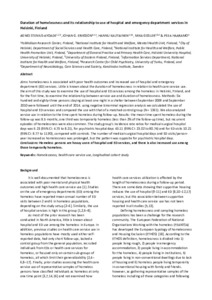Duration of homelessness and its relationship to use of hospital and emergency department services in Helsinki, Finland
Stenius-Ayoade A.; Eriksson J.; Kautiainen H.; Gissler M.; Haaramo P.
https://urn.fi/URN:NBN:fi-fe2021042824550
Tiivistelmä
Aims: Homelessness is associated with poor health outcomes and increased use of hospital and emergency department (ED) services. Little is known about the duration of homelessness in relation to health care service use. The aim of this study was to examine the use of hospital and ED services among the homeless in Helsinki, Finland, and for the first time, to examine the relationship between service use and duration of homelessness.
Methods: Six hundred and eighty-three persons staying at least one night in a shelter between September 2009 and September 2010 were followed until the end of 2014. Using negative binominal regression analysis we calculated the use of hospital and ED services and compared the use with that of a matched control group (N = 1361). We also analyzed service use in relation to the time spent homeless during follow-up.
Results: The mean time spent homeless during the follow-up was 8.5 months, one third was temporarily homeless (less than 2% of the follow-up time), but recurrent episodes of homelessness were also common. The study group’s incidence rate ratios for medical-surgical hospital days was 6.23 (95% CI: 4.73 to 8.21), for psychiatric hospital days 43.11 (95% CI: 23.02 to 80.74) and for ED visits 10.21 (95% CI: 8.77 to 11.90), compared with controls. The number of medical-surgical hospital days and ED visits/person-year increased as homelessness was prolonged, but the pattern was opposite for psychiatric hospital days.
Conclusions: Homeless persons are heavy users of hospital and ED services, and there is also increased use among those temporarily homeless.
Kokoelmat
- Rinnakkaistallenteet [27094]
